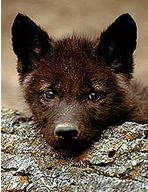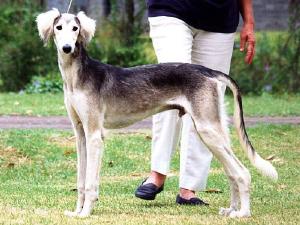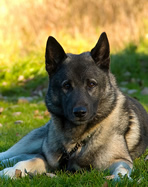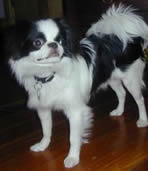
The Schipperke dog is small, with oval brown eyes, triangular upright ears
and a face that resembles that of a fox. The body must appear to be square
when viewed from the side while the chest must be wide and should reach the
elbows. It also has a distinctive double coat – a soft undercoat covered
by a rough, shaggy outer coat. A long ruff also surrounds the Schipperke’s
neck, particularly the nape, the chest as well as the back of its hind legs.
Life Expectancy:
15+ years
Energy Level:
Very high.
Living Conditions:
Indoor/Apartment.
Barking:
Average.
Exercise Needs:
Daily 20 minute walk. Gets some exercise on its own.
Breed Group:
Non-Sporting
Size:
Small
Height:
10 to 13 inches
Weight:
12 to 18 pounds
Standard Hair Colors:
Black for show dogs. Otherwise, tans and fawns are fine.
National breed club:
Schipperke Club of America
The Schipperke breed was developed in Flanders by a canal boat captain named Renssens. While it was originally planned to be descended from the Black Belgian Sheepdog family, the Schipperke was made smaller and was made to be a totally different breed. It was named Schipperke, which translates to “Little Skipper” or “Little Captain” in Flemish, because it was the favorite choice to guard canal barges in Belgium. The Schipperke became even more popular when Queen Marie Henriette acquired a dog of the said breed. Now, the Schipperke is regarded as a companion dog and is often brought along on boating and fishing trips because of its alert nature. Schipperke are well known as vermin hunters and watchdogs.
The Schipperke is a highly energetic dog that enjoys the companionship of other dogs, irregardless of size, and is curious about almost everything. The breed is very intelligent and independent, always in search of an adventure. It is also alert and is a perfect choice as a watchdog. It loves to howl and bark and is wary in the presence of strangers. In fact, the Schipperke is sometimes nicknamed “The Little Nurse” because it can be a quiet bedside companion to a sick family member.
Being an active and seemingly tireless dog, the Schipperke will love to run around the yard or better yet, in a park or open field.
Because of its size, the Schipperke is ideal for people living in apartments with small yards. However, the yard must have fences, as these dogs are very quick and can easily escape or get lost.
Being the independent dog that it is, the Schipperke can very well take care of its own grooming. The coat of the Schipperke must be brushed two to three times a week using a firm bristle brush to keep it in top condition. However, while they shed very little, Schipperkes experience periods of “blowing”, where they lose all their undercoat within a ten-day period. It is said that it is easier to bathe them during this time.
The Schipperke is prone to epilepsy, hip dysplasia and hypothyroid. The breed is also said to be susceptible to a new disease called MPS 111B.
You may also take a liking to the Shiba Inu. The breed, which can also be
mistaken for a fox because of the color of its coat, is very alert and independent,
perfect for families with small children. The Shiba Inu dog is also very gentle
and affectionate and loves to be part of a family.

 Saluki
Saluki
Saluki
Saluki
 Choosing a Finnish Lapphund - Finnish Lapphund Breed Profile
Choosing a Finnish Lapphund - Finnish Lapphun
Choosing a Finnish Lapphund - Finnish Lapphund Breed Profile
Choosing a Finnish Lapphund - Finnish Lapphun
 Azawakh
Azawakh
Azawakh
Azawakh
 Norwegian Elkhounds: A guide to dogs and puppies of the Norwegian Elkhound breed
The Norwegian Elkhound!
The Norwegian Elkhound is a hardy g
Norwegian Elkhounds: A guide to dogs and puppies of the Norwegian Elkhound breed
The Norwegian Elkhound!
The Norwegian Elkhound is a hardy g
 Japanese Spaniels: A guide to dogs and puppies of the Japanese Spaniel breed
The Japanese Spaniel!
This dog has a very elegant, high-ste
Japanese Spaniels: A guide to dogs and puppies of the Japanese Spaniel breed
The Japanese Spaniel!
This dog has a very elegant, high-ste
Copyright © 2005-2016 Pet Information All Rights Reserved
Contact us: www162date@outlook.com